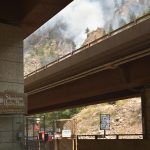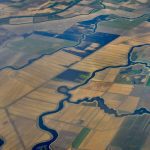- Nevada proposes a new water pollution control permit for an underground mine.
- The Victory Tungsten Mine would process up to 18,249 tons of ore each year.
- Tailings water would be recycled, with no authorized discharge to the environment.
- The public has thirty days to submit written comments.
Wednesday, November 26, 2025 —The Nevada Division of Environmental Protection released a proposed Water Pollution Control Permit yesterday for the Victory Tungsten Mine in Nye County . The application was filed by Nevada Rand LLC, which intends to restart underground tungsten production north of the town of Gabbs. The draft permit, fact sheet, and public notice outline how state regulators would oversee water protection at the site.
. The application was filed by Nevada Rand LLC, which intends to restart underground tungsten production north of the town of Gabbs. The draft permit, fact sheet, and public notice outline how state regulators would oversee water protection at the site.
A Small Underground Mine With a Long History.
According to the state’s draft fact sheet , tungsten deposits in the Lodi Mining District were first developed in the 1940s, but mining activity declined after the federal government ended its tungsten support price in the mid-1950s. The new project would operate on private land roughly eight miles from Gabbs and would use an underground portal system to access scheelite ore.
, tungsten deposits in the Lodi Mining District were first developed in the 1940s, but mining activity declined after the federal government ended its tungsten support price in the mid-1950s. The new project would operate on private land roughly eight miles from Gabbs and would use an underground portal system to access scheelite ore.
Nevada Rand proposes a modest test mill capable of processing 10 tons of ore per day. The operation would include a jaw crusher, hammer mill, gravity separation jig, and a concentrating table. Tailings would be dewatered, reused when possible, and ultimately placed underground as backfill.
What Tungsten Is Used For.
Tungsten is a strategic metal valued for its exceptional strength, durability, and resistance to heat. Because it has the highest melting point of any metal, it is commonly used in cutting tools, industrial machinery, drilling equipment, electrical contacts, specialty alloys, and the aerospace and defense sectors. Tungsten carbide, one of its most well-known forms, is prized for its hardness and is widely used in manufacturing and mining. These applications have made domestic supplies important for industry and national security.
Water Use and Groundwater Protection Measures.
Process water would be hauled from Gabbs. The mine is not expected to encounter groundwater because nearby well data show water levels more than 250 feet below the surface. The draft fact sheet states that no known surface waters occur within a half-mile of the site.
The project would rely on a small plastic-lined holding pond to store and clarify process water. State engineers note that the liner is intended for water conservation rather than to prevent contaminant leakage. The mine would operate under Nevada’s “no discharge” standard, meaning all water must remain within the fluid management system except in unusually large storm events.
Under the draft permit , Nevada Rand would be required to monitor water quality quarterly in the holding pond and annually at the Gabbs water supply that feeds the system. Sampling must comply with strict laboratory standards outlined in Nevada regulations.
, Nevada Rand would be required to monitor water quality quarterly in the holding pond and annually at the Gabbs water supply that feeds the system. Sampling must comply with strict laboratory standards outlined in Nevada regulations.
Monitoring for Nitrogen From Blasting Activities.
Material characterization tests identified elevated nitrogen in ore samples, which regulators attribute to blasting agents. Water from the holding pond will be tested quarterly to track any changes.
Stormwater, Inspections, and Reporting Requirements.
The project is located in an area where evaporation exceeds precipitation. Even so, the mine must be designed to contain water from a twenty-five-year, twenty-four-hour storm. Regular inspections would be required to identify erosion, equipment failures, or unexpected liquid accumulation in leak detection systems.
The permit includes detailed reporting rules covering quarterly monitoring, annual summaries, and immediate notification requirements in the event of a spill or equipment failure.
Protection of Migratory Birds.
The draft fact sheet highlights the federal Migratory Bird Treaty Act, which prohibits harming protected bird species. The fact sheet notes that open water can attract wildlife and that the U.S. Fish and Wildlife Service recommends physical barriers or chemical detoxification where toxic ponds are present.
How the Public Can Participate.
Nevada’s notice states that written comments will be accepted for thirty days following the November 25 posting date. Any interested person may request a public hearing during that period, provided the request explains why a hearing is warranted. If a hearing is held, it will take place in the area affected by the proposed discharge.
states that written comments will be accepted for thirty days following the November 25 posting date. Any interested person may request a public hearing during that period, provided the request explains why a hearing is warranted. If a hearing is held, it will take place in the area affected by the proposed discharge.
The Division has tentatively decided to issue the permit upon conclusion of the comment period.
Image: Entrance to the Premier Magnesium Mine in Gabbs, Nevada . Famartin, July 2014. Licensed under the Creative Commons Attribution-Share Alike 4.0 International license.
. Famartin, July 2014. Licensed under the Creative Commons Attribution-Share Alike 4.0 International license.
FAQ
What facility is seeking a permit?
The facility is the Victory Tungsten Mine, an underground tungsten mining and beneficiation operation proposed by Nevada Rand LLC.
Where is the mine located?
It is in Nye County, roughly eight miles north of Gabbs, within Section 22, Township 13 North, Range 36 East.
How much ore would the mine process?
Up to 18,249 tons per year, using a ten-ton-per-day test mill.
Will the mine use groundwater?
No. Process water would come from the town of Gabbs, and groundwater near the site lies more than 250 feet below the surface.
Does the project discharge water?
The draft permit requires a no-discharge system except under extreme storm conditions.
How will tailings be managed?
Tailings will be dewatered, reused when possible, and eventually placed underground as backfill.
How often will water quality be tested?
Quarterly testing will occur at the holding pond, and annual testing will occur at the water supply source.
What protections exist for wildlife?
The project must comply with the Migratory Bird Treaty Act, and the U.S. Fish and Wildlife Service may recommend additional protections around open water.
How can the public submit comments?
Written comments may be submitted within thirty days of the November 25 posting. A public hearing can be requested during the comment period.





